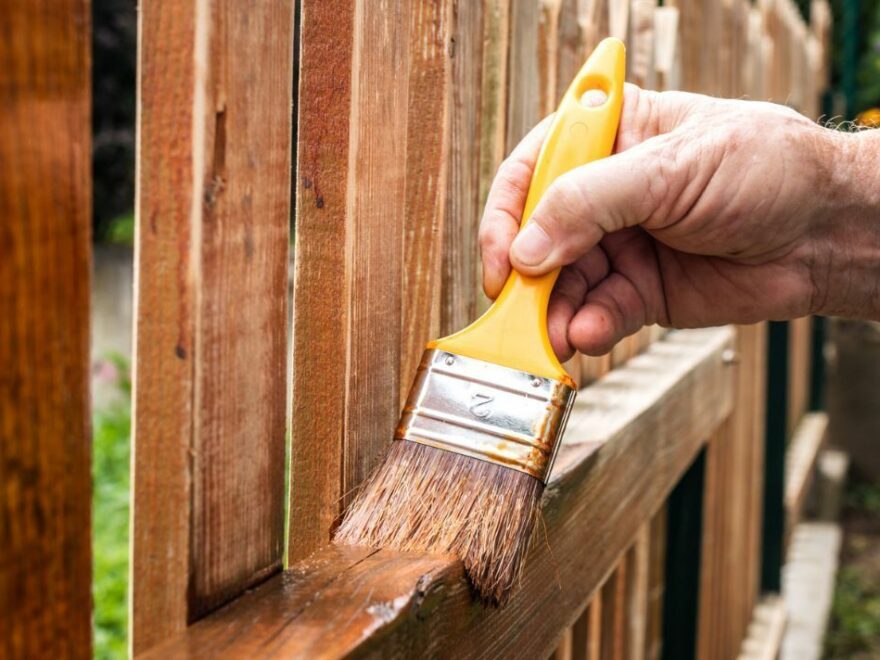
Fences play a huge part in garden landscapes, yet they are often one of the most neglect’s features of this outdoor space. The best way to make the most of a garden fence is to give it some TLC and a fresh coat of paint, so that it can be admired as the summer months soon approach. To assist gardeners on how to paint their fences, Phillipa Pawson, Marketing Director of Harris Brushes has shared her “best techniques for painting a fence to help you paint like a professional”, and it can be achieved in just three simple steps.
She said: “When it comes to upgrading the garden, patting a fence may be more straightforward than you think. With our easy-to-follow fence painting tips, you’ll be on your way to painting a fence like a professional in no time at all.
“Painting a fence is not only a simple way to make your garden look incredible for garden parties, gatherings and even outdoor reading during your downtime, it’s also vital for protecting your fence panels from moisture that can cause rot and mould to form in the wood.”
Step 1: Prepare the area
Typically, when painting a fence outdoors, people are far less concerned with spilling paint on the ground or surrounding plants.
However, to be safe and ensure the garden stays immaculate, the expert said: “We would recommend using tarpaulin (a waterproof material commonly used as a protective cover for outdoor areas) if you are planning to paint over brick, wooden decking or concrete to guarantee strong protection.”

For gardeners to protect themselves from any potential splashes, wear a protective suit and opt for old clothes to be extra safe.
Once the floor is suitably covered, tie back any climbing plants and cover any vulnerable plants using the tarpaulin.
Step 2: Inspect and resolve any issues with the fence
Phillipa claimed that this is a “vital step” when painting a fence. Gardeners need to examine the fence for any signs of damage including rot, mould or loose slats to ensure “paint glides on seamlessly”.
The expert urged: “Be mindful that simply painting over these problem areas will not resolve the issues in the long term and could potentially cause more daunting, time-consuming work at a later stage.”
Don’t miss…
Five minute ‘game-changing’ method to remove ‘tough’ air fryer grime [TIPS]
‘Cheap’ item to banish ‘black marks’ from your washing machine seal [COMMENT]
Weeds growing through gravel die ‘instantly’ with ‘effective’ 55p tip [INSIGHT]
This stage is the perfect opportunity to repair or replace any damaged areas and remove the risk of more costly jobs later down the line.
In some cases, depending on the type of fence households have, the panels may need to be replaced to ensure safety and prevent the garden from looking untidy.
With the fence checked and repaired or replaced it is then time to use a wire brush and scraper to clean up the fence panel and “achieve a smooth surface”.
Phillipa noted: “Only a light brushing is needed with the wire brush to eliminate any dirt or debris which might have accumulated over the year.”

Step 3: Apply the paint
Once the fence panels are perfectly prepared, shake the tin of fence paint, open the lid and stir the contents if necessary to remove any lumps.
The expert pointed out that the paint “must be of a smooth consistency with no patches of oil, water or other colours” to ensure smooth coverage is achieved.
Now it’s time to use a paint brush to paint the fence. Phillipa claimed: “Our Ultimate Swan Neck Shed and Fence Brush will make short work of applying the paint smoothly and evenly. Use this intelligent brush to work the paint into the wood covering all areas.
“Our rigorous testing has revealed that this brush achieves the coverage needed 40 percent faster than our previous block brush design, to reduce your painting time and deliver a stunning finish with every use.”

Once this step is complete, take a smaller brush to paint the frame and finish off any areas that require a higher level of intricacy.
After the fence has been painted, allow the paint to dry fully. For a deeper, darker colour add additional coats, being sure to wait for the required drying time between coats.
The expert said: “That’s all there is to it. You now have a remarkable looking garden and flawless fence panels that will remain well-protected from the summer through to the winter.”
For those looking for tips on how to paint inside their home, Express.co.uk have some great guide on how to paint a wall and how to paint a ceiling for professional results.
Source: Read Full Article
